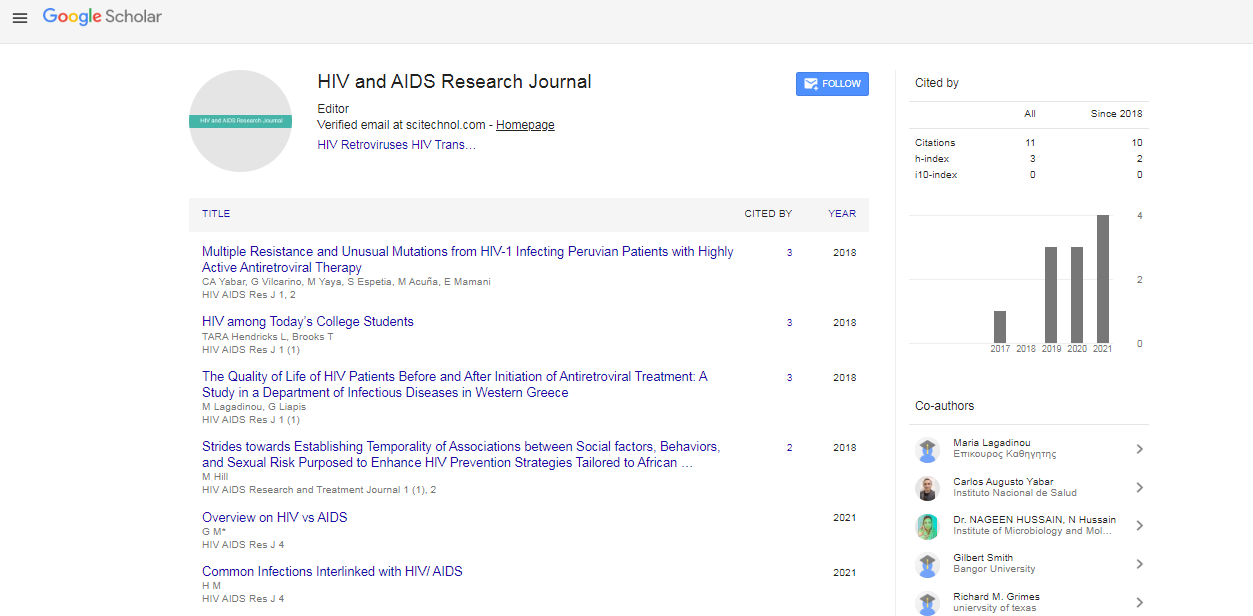Editorial, Hiv Aids Res Vol: 7 Issue: 1
Mother-to-Child Transmission of HIV in India
Anjali Nair*
Department of Obstetrics & Gynecology, Amrita Institute of Medical Sciences, Kochi, India
- *Corresponding Author:
- Anjali Nair
Department of Obstetrics & Gynecology, Amrita Institute of Medical Sciences, Kochi, India
E-mail: anjali.nair@aims.edu.in
Received: 01-Mar-2025, Manuscript No. HARJ-25-170195; Editor assigned: 4-Mar-2025, Pre-QC No. HARJ-25-170195 (PQ); Reviewed: 20-Mar-2025, QC No HARJ-25-170195; Revised: 26-Mar- 2025, Manuscript No. HARJ-25-170195 (R); Published: 30-Mar-2025, DOI: 10.4172/Harj.1000
Citation: Anjali Nair, Department of Obstetrics & Gynecology, Amrita Institute of Medical Sciences, Kochi, India. HIV AIDS Res J 7:1.
Copyright: © 2025 Anjali Nair, this is an open-access article distributed under the terms of the Creative Commons Attribution License, which permits unrestricted use, distribution, and reproduction in any medium, provided the original author and source are credited.
INTRODUCTION
Mother-to-child transmission (MTCT) is the primary route of HIV infection in children. Without intervention, transmission rates can be as high as 30–45%. India has adopted the Prevention of Parent-to-Child Transmission (PPTCT) program to reduce MTCT rates [1].
PPTCT Program
HIV testing during antenatal care, provision of lifelong ART to HIV-positive pregnant women, and safe delivery practices are central components of PPTCT. Studies show MTCT rates have declined to below 5% in many states [2]. Exclusive breastfeeding with maternal ART is also recommended to balance infant nutrition with reduced risk of HIV transmission [3].
CHALLENGES
Barriers include inadequate antenatal care coverage, stigma, and lack of follow-up testing for infants [4]. Innovative community-based interventions are helping improve PPTCT service uptake.
CONCLUSION
Strengthening antenatal testing and ART coverage is essential to achieve the goal of eliminating pediatric HIV in India.
REFERENCES
- NACO. PPTCT guidelines. Ministry of Health and Family Welfare, Govt of India.
- Mehta A. Outcomes of PPTCT in India. Indian Pediatr. 2016;53: 789–794.
- Bhatia R. Infant feeding and HIV transmission. J Trop Pediatr. 2010;56: 161–167.
- Chatterjee A. Barriers to PPTCT program. Indian J Community Med. 2015;40: 190–195.
- Joglekar N. Community-based interventions for PPTCT. AIDS Care. 2013;25: 999–1005.
 Spanish
Spanish  Chinese
Chinese  Russian
Russian  German
German  French
French  Japanese
Japanese  Portuguese
Portuguese  Hindi
Hindi 